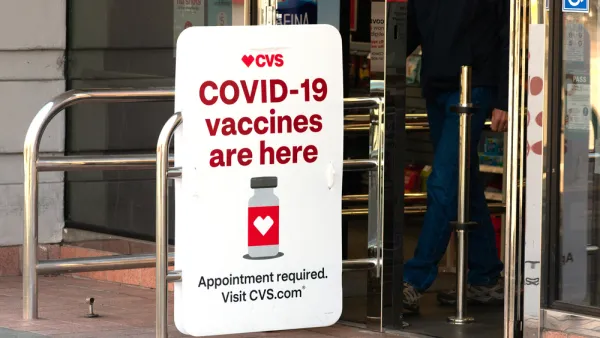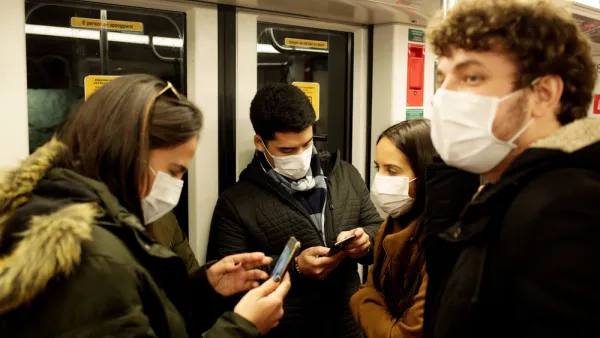The worst appears to be over, say most of the more than 20 experts who spoke with NPR's science editor, Rob Stein. If there is going to be a surge, it will be more like a ripple, he suggested. Not everyone agrees.

A recent Planetizen post based on reporting by Apoorva Mandavilli, a New York Times global health correspondent, indicated that a fourth coronavirus surge was "likely but not inevitable." Mandavilli's piece was originally published on Feb. 25, when daily new COVID-19 cases had plateaued at a seven-day rolling average of 69,450, shortly after they plunged for six weeks from a high of over 300,000 cases recorded on Jan. 8, according to the Times' coronavirus tracker.
On March 9, NPR's health correspondent, Rob Stein, presented a decidedly more upbeat assessment on the pandemic's trajectory based on his discussions with infectious disease experts, epidemiologists, public health officials, and medical historians. Daily new cases have dropped by a modest 16% to a seven-day rolling average of 58,543, showing a gradual decline on The New York Times graph since plateauing on Feb. 21.
"Now, not everyone is ready to say the worst could be over, but I checked in with more than 20 leading experts I've been talking with throughout the pandemic, and it's been pretty striking—most are," says Stein in the seven-minute radio report (source article with audio and transcript).
Dr. Ashish Jha, the dean of the Brown School of Public Health, told Stein, "I'm optimistic that the worst may, in fact, be behind us...that does feel really good."
Ali Mokdad at the University of Washington: "People will travel more, including myself. I will get on a plane and see my mom. Life will go back to normal"
Dr. Anthony Fauci, the medical advisor to President Joe Biden, told Stein:
"If all goes well, if we stick by the public health measures, if we effectively vaccinate, I think we are looking at a brighter future over the next several months. That's entirely conceivable and probably likely."
"Now, hot spots could flare up again because of the variants, you know, people getting careless, people who haven't gotten vaccinated," adds Stein. "But the trajectory of the pandemic could mostly keep going in the right direction."
Morning Edition host, Rachel Martin, asks him to be more specific.
[S]o what it means is that the number of people getting infected, sick and dying will hopefully slowly, but pretty steadily continue dropping from here on out, and life would slowly, but steadily return to something much more normal. Our new normal is finally in sight, people tell me. That's because of the vaccines, the fact that a chunk of the country already has some immunity, and the weather is getting warmer, which slows down the virus. So even if there is yet another wave, chances are it'll be more like, you know, like a ripple than another surge.
The one possible dark cloud in the pandemic horizon that Stein sees is not in the next few months but further off.
"The virus could surge again in the winter if the coronavirus follows the seasons, like the flu," states Stein. "But it hopefully shouldn't be anything like the horrific winter we just went through."
Surge ahead
Speaking of weather analogies, Dr. Michael T. Osterholm, director for the Center for Infectious Disease Research and Policy at the University of Minnesota, has his own.
"[W]e are in the eye of the hurricane right now," Osterholm told NBC anchor Chuck Todd of Meet the Press on March 7. He predicts a mutant storm to hit during "the next six to 14 weeks."
"It appears that things are going very well. You can see blue skies...But what we know is about to come upon us is the situation with this B117 variant, a virus that originated in the United Kingdom that today is wreaking havoc in parts of Europe, 27 countries seeing significant cases with this, ten really hitting hard...
"Last time I was on your show four weeks ago, the B117 variants made up about 1-4% of the viruses we were seeing in communities across the country. Today, it's up to 30-40%. And what we've seen in Europe, when we hit that 50% mark, you see cases surge.
Osterholm is so concerned about the coming surge that he is recommending that the vaccine strategy be altered, the topic of a New York Magazine article published March 8, aptly titled, "The Pandemic’s Dr. Doom Bets It All," referring to his surge prediction.
"He’s staking his credibility on being right, and potentially his health, by delaying his own second vaccine shot, which he says should be done across the country in order to make more first shots available to as many people as possible, offering some protection before the wave crests yet again," writes Melody Schreiber.
Osterholm wants to delay second doses of the two-shot Pfizer/BioNTech and Moderna vaccines for everyone else—but only until after the surge, which he expects to happen over the next two or three months. By then, the United States is expected to have enough doses to vaccinate all adults fully.
Historical perspective
Among those interviewed by Stein, the NPR health correspondent, was historian Keith Wailoo of Princeton University. "He said this pandemic is a world-changing event that has already reshaped a whole generation," states Stein.
With the one-year anniversary of the pandemic occurring on March 11, a look backward, from a historical perspective, might be helpful to determine what the future will look like.
"It has already been the case that the pandemic has had a profound impact on society, on basic questions like the nature of our social interactions," said Wailoo.
Stein speculates on how many of the changes will be long-lasting.
[W]ill the elbow bump replace the handshake for good? You know, looking back, the Black Death led to the Renaissance. The 1918 flu pandemic gave way to the Roaring '20s. We've just begun the new '20s. It's impossible to know what world will emerge as the virus recedes, but it seems pretty clear that we'll be hearing the echoes of this pandemic for a really long time.
Related in Planetizen:
- A Fourth Coronavirus Surge is Likely, March 1, 2021
-
Are We 'Rounding the Corner' in the Pandemic? February 16, 2021
-
Awaiting the Mutant Storm(s), February 4, 2021
- Coronavirus Declared a Pandemic. What Does That Mean? March 12, 2020
FULL STORY: Many Health Experts Believe Worst Of The Coronavirus May Be Over

National Parks Layoffs Will Cause Communities to Lose Billions
Thousands of essential park workers were laid off this week, just before the busy spring break season.

Retro-silient?: America’s First “Eco-burb,” The Woodlands Turns 50
A master-planned community north of Houston offers lessons on green infrastructure and resilient design, but falls short of its founder’s lofty affordability and walkability goals.

Delivering for America Plan Will Downgrade Mail Service in at Least 49.5 Percent of Zip Codes
Republican and Democrat lawmakers criticize the plan for its disproportionate negative impact on rural communities.

Test News Post 1
This is a summary

Test News Headline 46
Test for the image on the front page.

Balancing Bombs and Butterflies: How the National Guard Protects a Rare Species
The National Guard at Fort Indiantown Gap uses GIS technology and land management strategies to balance military training with conservation efforts, ensuring the survival of the rare eastern regal fritillary butterfly.
Urban Design for Planners 1: Software Tools
This six-course series explores essential urban design concepts using open source software and equips planners with the tools they need to participate fully in the urban design process.
Planning for Universal Design
Learn the tools for implementing Universal Design in planning regulations.
EMC Planning Group, Inc.
Planetizen
Planetizen
Mpact (formerly Rail~Volution)
Great Falls Development Authority, Inc.
HUDs Office of Policy Development and Research
NYU Wagner Graduate School of Public Service





























